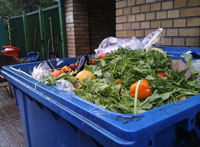Saturday, April 20, 2024
News and Views from the Global South
Groups Target Food Waste to Eliminate Hunger
- If all food loss and waste around the world could be recovered, half the world’s population, or 3.5 billion people, could be fed. Yet people throw away a third of food produced globally, an issue that inspired the theme of these year’s World Food Day, sustainable food systems for food security and nutrition.
While World Food Day, held Oct. 16, set the goal of completely eliminating food waste before increasing food production, much of the global population remains uneducated and uninformed about the problem, so many obstacles must be overcome before such a feat can be attained.
“I come from a country where people don’t even try to harvest agricultural products because the price of these products is so low and the work is too hard,” Albanian chef Fundim Gjpali told IPS while working at the Food and Agriculture Organisation’s World Food Day event organised at EATALY, a slow food hub in Rome.
Today, Gjpali is fighting food waste in the land of abundance: Europe. For World Food Day, he specially prepared a dish of recovered food. “I took tomatoes, bread and Italian ricotta cheese that were about to be thrown away, and I made a very decent dish,” he said.
Other countries, such as Cuba, represent the land of food recycling. “With the embargo in Cuba, we don’t have other choices,” Lesmer Oquedo Curbelo, a Cuban chef, told IPS. “A Cuban toreja, fried bread, is an example of how people could use stale bread.”
He compared food-buying practices in Cuba to those in Western countries. “In Cuba we buy food day by day,” he described. “Until you have eaten everything you’ve bought, you don’t go to the market.”
According to research by the FAO, nearly 1 billion people go to bed hungry each night. Even though food production will have to increase by at least 70 percent in order to feed a population that will reach 9 billion in 2050, the world wastes more than a third of the food that it is producing. And this waste affects everyone, regardless where they are born or live, and covers the entire food supply chain from the farm to the table.
According to FAO estimates, in developing countries, food waste tends to occur upstream of the food chain (six to eleven kilograms per capita in 2010), meaning that the food is lost just after production. In developed countries, however, loss occurs downstream, or in distribution, catering and domestic consumption (95-115 kilograms per person).
“While in the western world we only talk about the waste, in the developing countries the buzzword is the food loss,” Andrea Segrè, director of the Department of Agro-Food Science and Technology, University of Bologna and president of Last Minute Market, told IPS. Food waste differs from loss in that waste is literally throwing away food, while loss is due to a lack of storage. Many developing countries have plenty of food but no way to preserve.
“In India, for instance, the problem is not the lack of food but the storage,” explained Italian Minister of Foreign Affairs Emma Bonino. She stressed that regardless of personal habits, people must be aware of different ways to reduce food waste.
“On an individual level, we are supposed to think about the size of our food portions. We should also think about what and where we are buying food,” José Graziano da Silva, director-general of FAO, told IPS.
Andrea Segrè described to IPS a Last Minute Market, a spin-off society founded in 2000 that implemented the first professional system of recycling the unsold food of big distributors by filling in the gap between supply and demand. LMM doesn’t directly manage unsold food, instead offering services to prevent and reduce the production of waste.
“But our goal is to close the LMM, because we want to reach zero food loss,” Segrè added. “In that kind of world, we are not going to need projects like LMM.”

 Print
Print




